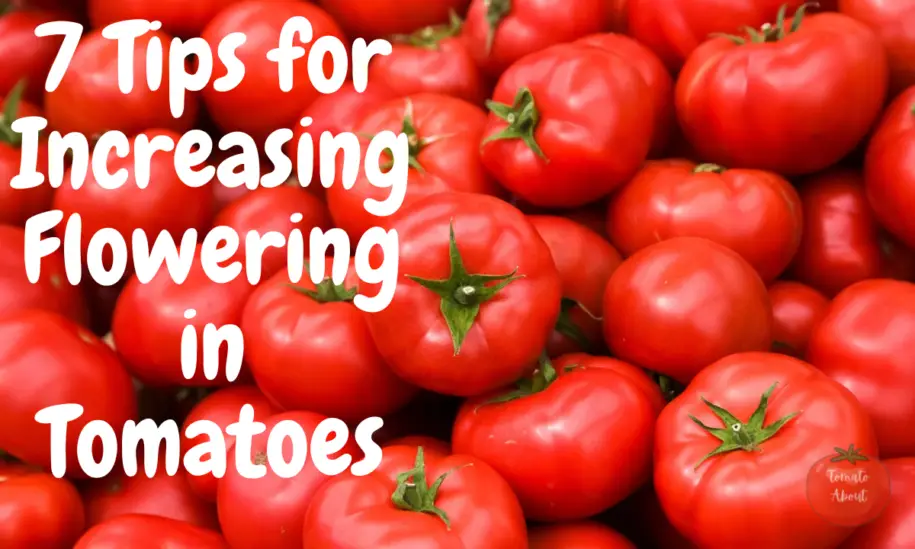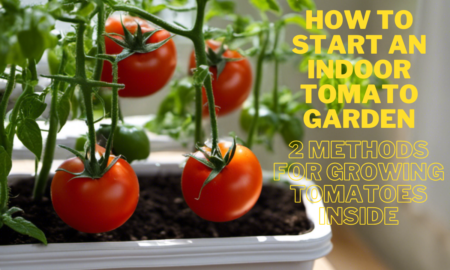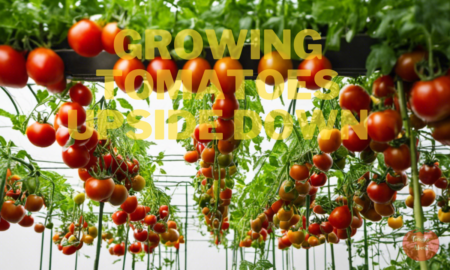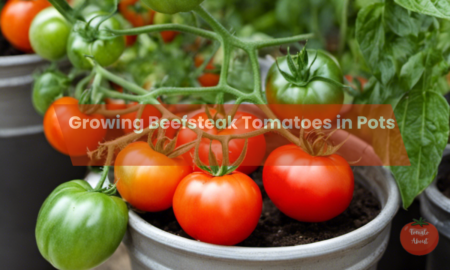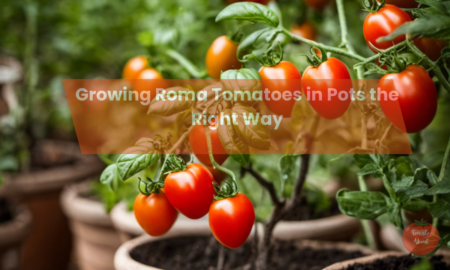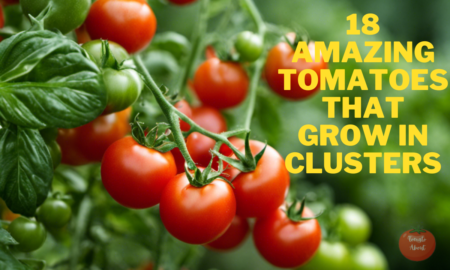Key Takeaways
- Choose compact, determinate tomato varieties for increased flower production.
- Provide ample direct sunlight, at least 6-8 hours a day, to encourage flowering.
- Use balanced fertilization to avoid excessive nitrogen and prioritize phosphorus and potassium for blossoms.
- Apply Epsom salt foliar sprays for magnesium to boost flower production.
- Maintain proper soil moisture with organic mulch, deep and consistent watering, and support tomato plants with stakes, cages, or trellises for healthier growth and more blossoms.
Growing a bountiful crop of tomatoes starts with getting plenty of flowers that will eventually turn into fruit. While some varieties naturally produce more flowers than others, there are things you can do to maximize flowering on any tomato plant.
After all, the number of flowers often determines the ceiling for how many tomatoes you’ll harvest. More flowers = more potential tomatoes.
So in this article, let’s dig into 7 tips for getting more flowers on tomato plants. Follow these techniques and you’ll be amazed at how many blossoms appear!
1. Start With Compact Determinate Varieties
One of the easiest ways to get more flowers is to grow compact, determinate tomato varieties. Determinate tomatoes stop growing vertically at a certain point, directing their energy into flower and fruit production rather than continued vegetative growth.
Some excellent compact varieties I’ve had success with include:
- Roma – A classic paste tomato, Roma is very compact and produces strings of pear-shaped red fruits.
- Celebrity – One of the most widely grown hybrids, Celebrity yields lots of robust, flavorful fruits on short plants.
- Jackpot – This hybrid bears abundant clusters of sweet red cherry tomatoes on a petite, container-friendly framework.
- Elfin – As the name suggests, Elfin is an ultra-compact red cherry tomato variety, reaching just 12-18 inches tall.
In my experience, all of these short, stocky varieties produce bumper crops of flowers and fruits. They put their energy into blossoming and fruiting rather than gaining size.
Meanwhile, indeterminate tomato varieties continue growing and branching all season long. They do bear flowers continuously but have less energy focused solely on flowering and fruiting. Some popular indeterminate types include Beefsteak, Brandywine, San Marzano, and Amish Paste.
While indeterminate tomatoes can produce well, determinate types typically excel at maximizing flowers and fruits. If you’re looking for a prolific harvest, go for compact determinate varieties like those listed above. You won’t be disappointed!
2. Give Tomato Plants Plenty of Direct Sunlight
No surprises here – tomato plants need abundant sunlight to thrive! Tomatoes are sun-loving plants. As a general rule, aim for at least 6-8 hours of direct sun exposure each day.
Early morning sun is best, before the midday heat kicks in. The less intense morning rays help dry dew from the plants, lowering disease risk. More sunlight equals more energy and photosynthesis to power vigorous growth and flowering.
When choosing a planting site, look for an area with maximum sun exposure and few obstructions like buildings or trees. Full sun from sunrise to sunset is ideal. My vegetable garden beds on the south side of the property get nearly 12 hours of sunlight in midsummer – tomato heaven!
If possible, avoid spots that receive shade in the mornings or afternoons. Tomatoes planted in part shade will grow leggy and struggle to flower properly.
I like to track where the sunlight falls throughout the day when sitting my tomato plants. Sunlight is one of those essential ingredients, right up there with fertile soil and regular watering. Take the time to find the sunniest spot in your yard for a bumper crop of blossoms.
A word of caution: Too much hot midday sun can lead to sunscald on developing fruits. Provide shade cloths as needed if the afternoon sun is intense in your climate. But always prioritize morning rays.
3. Use a Balanced Fertilizer Sparingly
It’s tempting to load tomato plants up with nitrogen-rich fertilizers to fuel plant growth. But heavier isn’t always better when it comes to tomato nutrition. Too much nitrogen leads to excessive leafy growth and few flowers. Lay off the fertilizer once plants start blooming.
Tomatoes need a balanced blend of nitrogen, phosphorus, and potassium. Phosphorus supports flowering and fruit production. Potassium aids in overall plant vigor and disease resistance. A moderate nitrogen level starts vegetative growth.
In most cases, avoid heavy doses of compost and manure, which can contain excess nitrogen. A diluted fish emulsion or kelp extract works well as a supplemental feeding. But go easy – tomatoes are sensitive!
Personally, I swear by using an organic balanced fertilizer called Tomato-Tone by Espoma. It contains nutrients in the ideal ratios for tomato growth, flowering, and fruiting. I apply it just once at planting time – no need to add more.
The takeaway? Use an even hand when fertilizing tomatoes. Avoid overapplying high-nitrogen products, especially after flowering begins. Stick to moderate, balanced feeding and your plants will thank you with blossoms galore.
4. Apply Epsom Salt as a Foliar Spray
Here’s a pro tip that can bring an explosion of new flowers: foliar spraying with Epsom salts. Epsom salts contain magnesium, which drives photosynthesis and is vital for proper tomato flowering.
Foliar feeding sends magnesium directly into plant tissues. And magnesium moves easily within the plant, getting to where it’s needed. A periodic Epsom salt spray gives tomato plants a direct shot of this critical mineral.
Mix 1 tablespoon of Epsom salts per gallon of water. Dissolve the crystals fully before spraying. Coat both the upper and lower leaves, as well as the stems. But avoid spraying the flowers directly, as the salts may interfere with pollination.
I make it a habit to foliar feed my tomato plants with Epsom salts every 2-3 weeks once flowering begins. This boosts magnesium levels for ongoing blossom production. Be patient when spraying – solubility takes time. But it’s worth it for the resulting tomato flowers!
If possible, spray in the morning on a dry, sunny day. This allows leaf surfaces to dry quickly, preventing disease issues. Magnesium AND fewer fungus problems? Now that’s what I call a winning combo.
5. Use Generous Organic Mulch
Proper mulching goes hand-in-hand with successful tomato flowering. An organic mulch layer moderates soil temperature and acts like a sponge, retaining moisture in the root zone. Regular soil moisture encourages blossoming.
I like to apply 3-4 inches of shredded bark, compost, leaf mold, or straw around each plant. Keep the mulch a few inches away from the main stems to avoid fungal problems. Deep mulch also prevents weeds from competing for water.
In my experience, straw or salt hay works especially well to maintain consistent moisture and soil fertility. As they slowly break down, the extra nutrients are released into the root zone as well. It’s a double win!
For even more heating benefits, you can use black plastic mulch. The black color absorbs heat, warming the soil significantly. Tomatoes love hot roots! Just be sure to cut holes for plants and use drip irrigation, as plastic mulch blocks rain.
No matter which mulch you choose, a thick layer keeps soil cooler on hot days and warmer when it’s chilly. Balance is the name of the game when it comes to tomato root zones. Give your plants some mulch love!
6. Practice Consistent Deep Watering
Proper watering and soil moisture go hand-in-hand with mulching when it comes to producing tomato flowers. Here are some key habits for success:
Water deeply – Tomatoes have extensive root systems, so saturate the soil to a depth of at least 6 inches when watering. Deep watering encourages roots to grow downwards into the root zone. Shallow watering leads to stunted, dysfunctional roots.
Water consistently – Tomato plants thrive with consistent soil moisture, not soggy wet or bone dry extremes. Allow the surface to dry out between waterings, then saturate deeply before wilting occurs.
Time it right – Water first thing in the morning, so the foliage has time to dry out during the day. This prevents diseases. Avoid overhead watering.
Use drip irrigation – Drip lines or soaker hoses deliver water right to the plant’s roots, without getting the leaves wet. This reduces fungal and bacterial problems.
Check soil – Probe the soil to monitor moisture levels, watering again when the top several inches become dry. Tomatoes need about 1-2 inches of water per week from irrigation and rainfall combined.
Follow these tips, and your well-watered tomato plants will reward you with a plethora of spectacular blossoms. Pay attention to their water needs and they’ll pay you back in fruits!
7. Support Tomato Plants with Stakes, Cages or Trellises
Finally, properly supporting tomato plants results in healthier growth, more sun exposure, and bountiful flowering. Tomatoes that sprawl on the ground become disease-prone and produce fewer blossoms. Here’s what I recommend:
Use tall stakes – Pound 5-6 foot stakes around each plant and gently tie the main stems to the supports as they grow. This keeps fruits up off the soil and prevents diseases.
Install tomato cages – Surround young plants with sturdy wire cages. Look for extra-tall options (5 feet or more) for indeterminate varieties that grow taller. Cages keep growth tidy and upright.
Build trellises – Construct vertical or A-frame trellises for tomatoes to climb. This supports the weighty vines and keeps fruits elevated into an easy-picking position.
Proper staking, caging, or trellising has multiple benefits:
- Keeps plants upright for better sun exposure
- Allows air circulation to lower disease risk
- Prevents fallen fruits from transmitting soil pathogens
- Reduces competition between plants for sunlight and nutrients
- Makes harvesting easier and improves fruit quality
Take it from me – well-supported tomato plants produce healthier, more abundant blossoms. Keep your plants organized vertically and you’ll be rewarded with a bountiful crop. It may seem like extra work at first, but you’ll reap the tomato benefits tenfold down the road.
Conclusion
There you have it – 7 techniques for getting tomato plants to produce more spectacular flowers, and ultimately more fruits for your kitchen. As both a passionate gardener and tomato lover, I highly recommend giving these methods a try in your own garden.
Follow this advice for choosing compact varieties, siting plants properly, fertilizing judiciously, and supporting vines. Add in smart watering, Epsom salts, and mulch for good measure. Do these things and you’ll have so many blossoms you won’t know what to do with them all!

